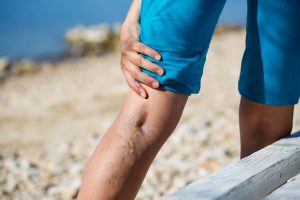Varicose Vein Symptoms
 To many, the idea of varicose vein symptoms may seem cut and dry– nothing more than bulgy, rope-like, purple or blueish veins. But there is more here than meets the eye. The following are other symptoms of this venous disease, often (but not always) occurring on/in the legs:
To many, the idea of varicose vein symptoms may seem cut and dry– nothing more than bulgy, rope-like, purple or blueish veins. But there is more here than meets the eye. The following are other symptoms of this venous disease, often (but not always) occurring on/in the legs:
- Leg pain, often worsened from prolonged sitting or standing
- Burning, throbbing, swelling, and/or muscle cramps in the legs
- Restless legs
- Heaviness, achiness, and/or tingling in the legs
- Discoloration of veins or legs
- Whitish patches and/or swelling around ankles
- Bleeding and/or skin ulcers from veins
- Reddish or brownish discoloration, dryness, and/or Itching around veins
- Spider veins
Some of these symptoms can be present independent of one another. One person may have bulging, discolored veins without any pain, and another may experience pain and other unpleasant sensations in their legs before the veins become noticeable. In cases in which the abovementioned symptoms are ignored or missed, there is a small chance that complications can arise, including:
- Bleeding from burst veins
- Skin ulcers or open sores adjacent to veins
- Fungal and/or bacterial infections resulting from ulcers
- Blood clots or deep vein thrombosis (DVT)
- Pulmonary embolism
- Lipodermosclerosis (hardening of leg tissue due to prolonged inflammation)
While rare, varicose veins can also be a symptom of chronic veinous insufficiency (CVI), a result of weakened or damaged valves within deep veins and superficial (closer to the surface of the skin) veins. The complications of CVI are similar to those of varicose veins and can be life-threatening.
Whether your symptoms are just beginning or you suspect your varicose veins may be a result of CVI, the best thing you can do for your health is to visit our vein specialists as soon as possible to accurately diagnose the root of the issue and treat it as quickly and painlessly as possible. Let our vein specialists provide you with the treatment you deserve.